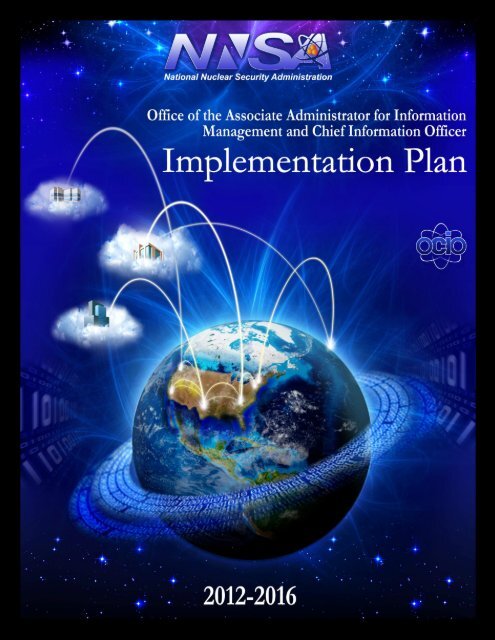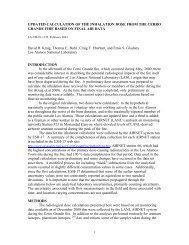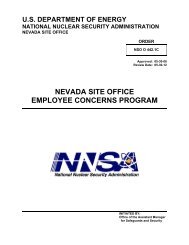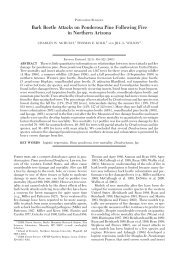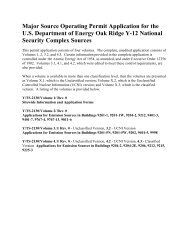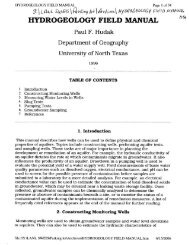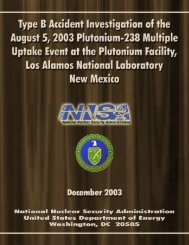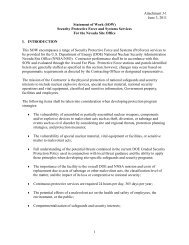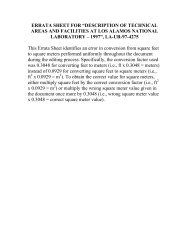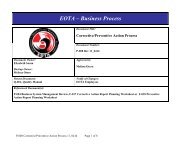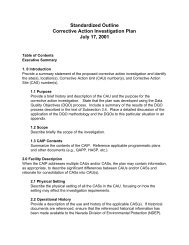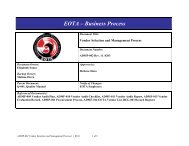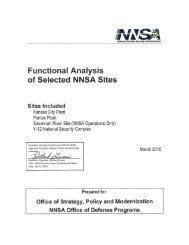NNSA CIO Implementation Plan for IT 2012-2016 - National Nuclear ...
NNSA CIO Implementation Plan for IT 2012-2016 - National Nuclear ...
NNSA CIO Implementation Plan for IT 2012-2016 - National Nuclear ...
You also want an ePaper? Increase the reach of your titles
YUMPU automatically turns print PDFs into web optimized ePapers that Google loves.
Message from the Administrator<br />
President Obama has reshaped our national security priorities making<br />
enterprise infrastructure modernization with integrated In<strong>for</strong>mation<br />
Technology (<strong>IT</strong>) capabilities a key strategic initiative. Our <strong>IT</strong> infrastructure<br />
must ensure that our work<strong>for</strong>ce can access appropriate in<strong>for</strong>mation in a<br />
secure, reliable, and cost-effective manner. Effective in<strong>for</strong>mation sharing<br />
throughout the government enhances the national security of the United<br />
States (US). For the <strong>National</strong> <strong>Nuclear</strong> Security Administration (<strong>NNSA</strong>),<br />
effective in<strong>for</strong>mation sharing helps strengthen our nuclear security mission;<br />
builds collaborative networks within <strong>NNSA</strong> as well as with the Department of<br />
Energy (DOE), Department of Defense (DoD), and other national security<br />
components; improves the foundation, speed, and execution of decision<br />
making; and helps improve the ability to anticipate events and resource<br />
needs. This <strong>Implementation</strong> <strong>Plan</strong> is being issued to provide direction to<br />
<strong>NNSA</strong>’s in<strong>for</strong>mation sharing and modernization ef<strong>for</strong>ts by detailing goals and<br />
objectives necessary to build a strong <strong>IT</strong> infrastructure.<br />
Every individual and organization within <strong>NNSA</strong> will play an important role in<br />
improving our <strong>IT</strong> environment. Successful implementation of this strategy will<br />
result in efficiencies of operation, enhanced and shared operational<br />
awareness, and mission success. I look <strong>for</strong>ward to working with each of you<br />
on this important initiative to achieve “One<strong>NNSA</strong>.”<br />
Thomas P. D’Agostino<br />
Administrator, <strong>National</strong> <strong>Nuclear</strong> Security Administration<br />
Message from the Associate Administrator <strong>for</strong> In<strong>for</strong>mation<br />
Management and Chief In<strong>for</strong>mation Officer<br />
I am pleased to present the <strong>NNSA</strong> In<strong>for</strong>mation Management <strong>Implementation</strong><br />
<strong>Plan</strong>, which codifies our vision <strong>for</strong> providing an enhanced computing<br />
environment and increased cyber security posture today, while looking<br />
<strong>for</strong>ward towards meeting tomorrow’s technology and challenges.<br />
Trans<strong>for</strong>ming <strong>NNSA</strong> from keepers of the <strong>Nuclear</strong> Weapons Complex to a<br />
fully integrated <strong>Nuclear</strong> Security Enterprise (NSE) requires that in<strong>for</strong>mation<br />
be viewed as a strategic asset and <strong>for</strong>ce multiplier.<br />
We will be investing in cutting edge in<strong>for</strong>mation technology and teaming with<br />
the best and brightest people in order to ensure that we deliver our desired<br />
collaborative capabilities and cyber security posture in support of<br />
“One<strong>NNSA</strong>.”<br />
I look <strong>for</strong>ward to working with each of you as we achieve the goals set <strong>for</strong>th<br />
in this plan.<br />
Robert J. Osborn, II<br />
Associate Administrator <strong>for</strong> In<strong>for</strong>mation Management and Chief In<strong>for</strong>mation Officer,<br />
<strong>National</strong> <strong>Nuclear</strong> Security Administration
TABLE OF CONTENTS<br />
EXECUTIVE SUMMARY .......................................................................................................................................... III<br />
INTRODUCTION ..................................................................................................................................................... 1<br />
OVERVIEW ................................................................................................................................................................... 1<br />
STRATEGIC GOALS .......................................................................................................................................................... 2<br />
<strong>NNSA</strong> NETWORK VISION (2NV) STRATEGY BACKGROUND .................................................................................................... 2<br />
STAKEHOLDERS .............................................................................................................................................................. 3<br />
INFORMATION MANAGEMENT STRATEGIC GOALS ................................................................................................ 4<br />
FOCUS AREA 1: ENCHANCING OUR CAPABIL<strong>IT</strong>IES ..................................................................................................... 4<br />
Strategic Goal 1-1: Collapse and Consolidate Networks, Applications, and Services into Virtualized<br />
Environments ....................................................................................................................................................... 4<br />
Strategic Goal 1-2: Build the Next Generation Mobile Infrastructure .................................................................. 4<br />
Strategic Goal 1-3: Leverage the Power of the Cloud to Enable a Low Cost, Shared Services Model .................. 5<br />
Strategic Goal 1-4: Establish Risk-Based Cyber Security Governance .................................................................. 5<br />
Strategic Goal 1-5: Improve Business Processes .................................................................................................. 6<br />
FOCUS AREA 2: UNDERSTANDING OUR ENVIRONMENT ........................................................................................... 7<br />
Strategic Goal 2-1: Provide Real-Time Situational Awareness of <strong>NNSA</strong> Networks and Systems .......................... 7<br />
Strategic Goal 2-2: Operationalize Research in Next Generation Cyber Security Defenses ................................. 7<br />
Strategic Goal 2-3: Improve Cyber Security Incident Management Capabilities .................................................. 8<br />
Strategic Goal 2-4: Provide Continuous Monitoring Capabilities <strong>for</strong> <strong>NNSA</strong> Networks and Systems .................... 8<br />
FOCUS AREA 3: PROTECTING OUR FUTURE ............................................................................................................... 9<br />
Strategic Goal 3-1: Invest in Cutting Edge Research on Cyber Security Defenses ................................................ 9<br />
Strategic Goal 3-2: Apply Risk-Based Budgeting Processes <strong>for</strong> Cyber Security .................................................... 9<br />
Strategic Goal 3-3: Improve Stakeholder Involvement in <strong>NNSA</strong> <strong>IT</strong> Programs .................................................... 10<br />
Strategic Goal 3-4: Develop an Enterprise Governance Process <strong>for</strong> <strong>IT</strong> Investments ........................................... 10<br />
ENVIRONMENT, CONTEXT, AND ALIGNMENT ...................................................................................................... 11<br />
STRATEGIC PILLARS .............................................................................................................................................. 12<br />
<strong>NNSA</strong> NETWORK VISION (2NV) .................................................................................................................................... 13<br />
JOINT CYBERSECUR<strong>IT</strong>Y COORDINATION CENTER (JC3) ......................................................................................................... 15<br />
CYBER SCIENCES LABORATORY (CSL) ............................................................................................................................... 15<br />
STRATEGIC IN<strong>IT</strong>IATIVES ........................................................................................................................................ 17<br />
CONGRESSIONAL AND OFFICE OF MANAGEMENT AND BUDGET (OMB) ENGAGEMENT ............................................................. 17<br />
CONTINUOUS MON<strong>IT</strong>ORING........................................................................................................................................... 17<br />
CYBER SECUR<strong>IT</strong>Y RISK MANAGEMENT FRAMEWORK ........................................................................................................... 18<br />
ENTERPRISE SECURE NETWORK (ESN) ............................................................................................................................. 18<br />
ENTERPRISE WIRELESS .................................................................................................................................................. 18<br />
EXECUTION AND GOVERNANCE MODEL FOR INFORMATION TECHNOLOGY (EGM<strong>IT</strong>)................................................................. 19<br />
i
IMPROVED ACQUIS<strong>IT</strong>ION AND SUPPLY CHAIN .................................................................................................................... 20<br />
THE PATH FORWARD ........................................................................................................................................... 21<br />
APPENDIX A: ACRONYMS .................................................................................................................................... 22<br />
LIST OF FIGURES<br />
FIGURE 1: OMB MEMORANDUM FOR <strong>CIO</strong> AUTHOR<strong>IT</strong>IES ....................................................................................... 1<br />
FIGURE 2: THREE STRATEGIC PILLARS .................................................................................................................. 12<br />
FIGURE 3: 2NV “CLOUD OF CLOUDS” ................................................................................................................... 13<br />
FIGURE 4: 2NV CONCEPTUAL ARCH<strong>IT</strong>ECTURE BY SERVICE LAYERS ....................................................................... 14<br />
FIGURE 5: JC3 PROGRAM ..................................................................................................................................... 15<br />
FIGURE 6: CSL PROGRAM ..................................................................................................................................... 15<br />
FIGURE 7: ESN PROJECT ....................................................................................................................................... 18<br />
FIGURE 8: NOTIONAL WIRELESS ARCH<strong>IT</strong>ECTURE .................................................................................................. 19<br />
FIGURE 9: ENTERPRISE GOVERNANCE MODEL ..................................................................................................... 19<br />
LIST OF TABLES<br />
TABLE 1: FOCUS AREA MAP TO STRATEGIC IN<strong>IT</strong>IATIVES ......................................................................................... 2<br />
TABLE 2: ALIGNMENT BETWEEN 25 POINT IMPLEMENTATION PLAN AND STRATEGIC IN<strong>IT</strong>IATIVES ....................... 3<br />
TABLE 3: ALIGNMENT TO DOE AND <strong>NNSA</strong> STRATEGIC PLANS .............................................................................. 11<br />
ii
EXECUTIVE SUMMARY<br />
Associate Administrator <strong>for</strong> In<strong>for</strong>mation Management and Chief In<strong>for</strong>mation Officer’s Intent<br />
Our focus <strong>for</strong> the next five years is to trans<strong>for</strong>m the <strong>NNSA</strong> computing environment in support of the<br />
Administrator’s “One<strong>NNSA</strong>” vision. We will accomplish this by delivering three pillars of our strategy: the<br />
<strong>NNSA</strong> Network Vision (2NV), the Joint Cybersecurity Coordination Center (JC3) and the Cyber Sciences<br />
Laboratory (CSL). 2NV will enhance and modernize our current environment by providing a secure,<br />
mobile, agile and adaptive <strong>IT</strong> infrastructure which will allow our work<strong>for</strong>ce to per<strong>for</strong>m their duties from any<br />
device, anywhere, at any time. JC3 will allow us to understand the “health” of that computing environment<br />
from a cyber security and network operations perspective. CSL will provide research and development<br />
capabilities which will ensure our future ability to achieve the <strong>NNSA</strong> mission. We will develop and use a<br />
comprehensive Enterprise Architecture (EA) to guide our path towards achieving our end state, and will<br />
manage investments towards that achievement via a structured enterprise governance process.<br />
Vision<br />
We will provide a secure, mobile, agile, device agnostic computing environment which supports the needs<br />
of the <strong>NNSA</strong> now and into the future.<br />
Mission<br />
The mission of the <strong>NNSA</strong> Associate Administrator <strong>for</strong> In<strong>for</strong>mation Management and Chief In<strong>for</strong>mation<br />
Officer (<strong>CIO</strong>) is to provide state of the art communications technology and services which support the<br />
<strong>NNSA</strong> lines of business, in the most efficient manner possible, with a resulting increase in cyber security<br />
posture.<br />
Strategic Goals<br />
To achieve the “One<strong>NNSA</strong>” vision, the <strong>NNSA</strong> Office of the Associate Administrator <strong>for</strong> In<strong>for</strong>mation<br />
Management and Chief In<strong>for</strong>mation Officer (O<strong>CIO</strong>) has developed three strategic focus areas along with<br />
supporting goals and initiatives to be accomplished within the next five years using light technologies and<br />
best practices to provide enterprise-wide services in a cost effective and efficient manner.<br />
iii
INTRODUCTION<br />
Overview<br />
The <strong>NNSA</strong> In<strong>for</strong>mation Management <strong>Implementation</strong> <strong>Plan</strong> provides a roadmap <strong>for</strong> the future of <strong>NNSA</strong><br />
In<strong>for</strong>mation Technology (<strong>IT</strong>) and cyber security within the context of the broader <strong>NNSA</strong> Network Vision<br />
(2NV). The <strong>NNSA</strong> Office of the Associate Administrator <strong>for</strong> In<strong>for</strong>mation Management and Chief<br />
In<strong>for</strong>mation Officer (O<strong>CIO</strong>) has the responsibility to manage assured in<strong>for</strong>mation collaboratively within the<br />
<strong>Nuclear</strong> Security Enterprise (NSE) as a key enabler and trans<strong>for</strong>mational agent that ensures program,<br />
operational and business excellence in the accomplishment of the <strong>NNSA</strong> mission in a safe, secure, and<br />
efficient manner.<br />
Changes in the Role of the Chief In<strong>for</strong>mation<br />
Officer<br />
In December 2010, the Administration released<br />
the 25 Point <strong>Implementation</strong> <strong>Plan</strong> to Re<strong>for</strong>m<br />
Federal In<strong>for</strong>mation Technology Management (25<br />
Point <strong>Implementation</strong> <strong>Plan</strong>). The 25 Point<br />
<strong>Implementation</strong> <strong>Plan</strong> focuses on eliminating<br />
barriers that get in the way of effectively<br />
managing <strong>IT</strong> programs throughout the Federal<br />
government. Furthermore, in August 2011, the<br />
Office of Management and Budget (OMB)<br />
released M-11-29, Chief In<strong>for</strong>mation Officer<br />
Authorities, to re-emphasize the initiatives of the<br />
25 Point <strong>Implementation</strong> <strong>Plan</strong> and the changes in<br />
the role of Chief In<strong>for</strong>mation Officers (<strong>CIO</strong>s) from<br />
just policymaking and infrastructure maintenance,<br />
to encompass true portfolio management <strong>for</strong> all<br />
<strong>IT</strong>. In addition to their statutory responsibilities<br />
through the Clinger-Cohen Act and related laws, <strong>CIO</strong>s<br />
are now empowered to improve the operating<br />
efficiency of their Agencies by having a lead role in the following four business functions:<br />
1. Governance<br />
2. Commodity <strong>IT</strong><br />
3. Program Management<br />
4. In<strong>for</strong>mation Security<br />
Agency <strong>CIO</strong>s will be held accountable <strong>for</strong> lowering operational costs, terminating and turning around<br />
troubled projects, and delivering meaningful functionality at a faster rate while enhancing the security of<br />
in<strong>for</strong>mation systems. These additional responsibilities will enable <strong>CIO</strong>s to reduce the number of wasteful<br />
duplicative systems, simplify services <strong>for</strong> the American people, and deliver more effective <strong>IT</strong> to support<br />
their Agency’s mission.<br />
Figure 1: OMB Memorandum <strong>for</strong> <strong>CIO</strong><br />
Authorities<br />
1
Strategic Goals<br />
To achieve the <strong>NNSA</strong> Administrator’s “One<strong>NNSA</strong>” vision and support the 25 Point <strong>Implementation</strong> <strong>Plan</strong>,<br />
the <strong>NNSA</strong> O<strong>CIO</strong> has developed a set of strategic focus areas, strategic goals, and strategic initiatives,<br />
integrated through the 2NV strategy, to accomplish within the next five years using light technologies and<br />
best practices to provide enterprise-wide services in a cost effective and efficient manner.<br />
Table 1: Focus Area Map to Strategic Initiatives<br />
Focus Area Goals Pillars/Initiatives<br />
Enhancing Our Capabilities<br />
Understanding Our<br />
Environment<br />
Protecting Our Future<br />
Consolidation<br />
Mobility<br />
Cloud Computing<br />
Risk Management<br />
Business Process Management<br />
Situational Awareness<br />
Operationalizing Research<br />
Incident Management<br />
Continuous Monitoring<br />
Investment in Cyber Defense<br />
Research<br />
Risk-Based Budgeting<br />
Stakeholder Involvement<br />
Governance<br />
<strong>NNSA</strong> Network Vision (2NV)<br />
Enterprise Wireless<br />
Risk Management Framework (RMF)<br />
Enterprise Secure Network (ESN)<br />
Improved Acquisition & Supply Chain<br />
Joint Cybersecurity Coordination<br />
Center (JC3)<br />
Continuous Monitoring<br />
Cyber Sciences Laboratory (CSL)<br />
Congressional and Office of<br />
Management and Budget (OMB)<br />
Engagement<br />
Execution and Governance Model <strong>for</strong><br />
In<strong>for</strong>mation Technology (EGM<strong>IT</strong>)<br />
<strong>NNSA</strong> Network Vision (2NV) Strategy Background<br />
The current <strong>IT</strong> resources are located within the <strong>NNSA</strong> Headquarters (HQ), three national laboratories,<br />
four production sites, and the <strong>National</strong> <strong>Nuclear</strong> Security Site (NNSS). Each site is geographically<br />
distributed and represents approximately $2 billion in <strong>IT</strong> capital assets. Current <strong>IT</strong> investments are stove<br />
piped and not standardized across the enterprise. Costs to maintain current <strong>IT</strong> investments translate into<br />
postponement of mission work. <strong>IT</strong> labor and data costs are replicated significantly to support multiple<br />
infrastructures, multiple networks, and excess legacy data centers.<br />
The 2NV strategy, in concert with the other strategic pillars, such as JC3 and CSL, will trans<strong>for</strong>m <strong>NNSA</strong><br />
into a leading Federal organization that aggressively pursues the initiatives in the 25 Point<br />
<strong>Implementation</strong> <strong>Plan</strong>.<br />
2
Table 2: Alignment between 25 Point <strong>Implementation</strong> <strong>Plan</strong> and Strategic Initiatives<br />
OMB Initiative<br />
Shift to a “Cloud First” policy<br />
Identify 3 Must Move Cloud Services<br />
Reduce the Number of Federal Data<br />
Centers<br />
Improving <strong>IT</strong> Project Execution<br />
Deliver Infrastructure as a Service (IaaS)<br />
solution<br />
Develop a Strategy <strong>for</strong> Shared Services<br />
<strong>NNSA</strong> <strong>Implementation</strong><br />
Collection of private clouds will provide initial shared services, and<br />
policy updates will make cloud solutions the preferred alternative <strong>for</strong><br />
future <strong>IT</strong> projects.<br />
2NV will move email, web conferencing, instant messaging, and web<br />
portals into the cloud during the first phase.<br />
Deployment of private clouds will facilitate the retirement of legacy<br />
data centers as applications and systems are transitioned. In addition,<br />
2NV will leverage commercial data centers instead of building and<br />
managing independent Federal data centers.<br />
The Execution and Governance Model <strong>for</strong> In<strong>for</strong>mation Technology<br />
(EGM<strong>IT</strong>) will allow project management requirements to be specifically<br />
tailored <strong>for</strong> <strong>IT</strong> success instead of leveraging a common process with<br />
construction projects. The approach will deliver projects faster, in<br />
smaller chunks, and with an improved portfolio management process.<br />
IaaS will enable <strong>NNSA</strong> to transition to a standard virtualized desktop<br />
<strong>for</strong> improved security and lower cost of ownership.<br />
The CSL can further increase the attractiveness of Department of<br />
Energy (DOE) investments by providing a central mechanism <strong>for</strong><br />
sharing results (where appropriate) amongst all of the participating<br />
Agencies. The sharing concept ensures each Agency sees the result<br />
from all government investments; not just their own. In addition, the<br />
CSL will directly feed research results into DOE through the JC3.<br />
Ultimately, the strategic initiatives will trans<strong>for</strong>m the Administration’s <strong>IT</strong> infrastructure into an<br />
interconnected, agile, secure, and efficient computing environment <strong>for</strong> the NSE. The <strong>NNSA</strong> strategy<br />
tackles the full spectrum of issues facing our <strong>IT</strong>/Cyber programs by delivering an integrated and secure<br />
<strong>NNSA</strong> “cloud” architecture. It achieves efficiency by reducing redundancy and it increases effectiveness<br />
and security through an integrated architecture that focuses on shared services, virtualized environments,<br />
and mobile architectures.<br />
Stakeholders<br />
Enterprise stakeholders are both our customers and strategic partners. Both are critical to our mission.<br />
They include:<br />
Department of Defense (DoD)<br />
Department of Energy (DOE)<br />
Department of Homeland Security (DHS)<br />
Department of State (DoS)<br />
Industry<br />
Intelligence Community<br />
Interagency Partners<br />
Management and Operating (M&O) Contractors<br />
Multi-national Organizations<br />
Non-DoD US Federal Agencies<br />
United Kingdom<br />
The American people<br />
3
INFORMATION MANAGEMENT STRATEGIC GOALS<br />
FOCUS AREA 1: ENCHANCING OUR CAPABIL<strong>IT</strong>IES<br />
Strategic Goal 1-1: Collapse and Consolidate Networks,<br />
Applications, and Services into Virtualized<br />
Environments<br />
Individual services are being maintained by Headquarters,<br />
labs, and plants that essentially per<strong>for</strong>m the same function.<br />
These services require site data storage and administration,<br />
infrastructure, and software. Where this common service<br />
exists across sites, these need to be identified and migrated<br />
to a virtualized service solution. This will provide<br />
standardization and reduce maintenance ef<strong>for</strong>ts while<br />
enabling all customers to benefit at the same time from<br />
future upgrades or enhancements.<br />
Strategic Goal 1-1 Objectives:<br />
Leverage <strong>National</strong> Security Agency (NSA)<br />
Suite B technology to replace the majority<br />
of existing classified networks and<br />
machines (ability to go high-side from the<br />
green environment).<br />
Leverage Voice over IP (VOIP) technology<br />
to replace the majority of NSE stand-alone<br />
voice systems.<br />
Apply an enterprise architecture approach<br />
to redesign the <strong>NNSA</strong> unclassified<br />
networks into one integrated NSE network.<br />
Consolidate data centers throughout the<br />
NSE to reduce energy, labor, and hardware<br />
costs.<br />
Apply an aggressive virtualization strategy<br />
to minimize hardware and labor<br />
requirements <strong>for</strong> <strong>IT</strong> systems.<br />
Strategic Goal 1-2: Build the Next Generation Mobile<br />
Infrastructure<br />
Mobile computing is a versatile and potentially strategic<br />
technology that improves in<strong>for</strong>mation quality and<br />
accessibility. Mobile technology is also a great enabler of<br />
shared <strong>IT</strong> services and can reduce <strong>IT</strong> costs. It reduces the<br />
need <strong>for</strong> distributed <strong>IT</strong> resources while allowing centralized<br />
computing that can be more robust and efficient.<br />
Additionally, mobile technology improves operational<br />
efficiency by allowing the worker to create, access, process,<br />
store and communicate in<strong>for</strong>mation without being<br />
constrained to a single location. Within the <strong>NNSA</strong><br />
environment, this must be implemented without any adverse<br />
impact to security.<br />
Strategic Goal 1-2 Objectives:<br />
Transition to secure wireless technology as<br />
the preferred approach <strong>for</strong> last-mile<br />
connectivity throughout the NSE (indoor<br />
and outdoor).<br />
Leverage NSA Suite B solutions to develop<br />
a classified wireless capability <strong>for</strong> the NSE.<br />
Invest in secure mobile solutions <strong>for</strong> next<br />
generation plat<strong>for</strong>ms to move beyond the<br />
Blackberry.<br />
Build secure, wireless sensor and Radio<br />
Frequency Identification (RFID) networks to<br />
eliminate and/or optimize manual labor<br />
processes.<br />
4
Strategic Goal 1-3: Leverage the Power of the Cloud to<br />
Enable a Low Cost, Shared Services Model<br />
After implementation, cloud computing will provide low cost<br />
software on a large scale, with advanced security in a<br />
homogeneous or common environment. It provides on<br />
demand access from anywhere and will allow resources to<br />
be pooled. In addition, as the infrastructure, plat<strong>for</strong>ms, and<br />
software are migrated to the cloud, better business<br />
intelligence or analytics will be achieved; clouds <strong>for</strong> the labs,<br />
the plants, and headquarters can be constructed to optimize<br />
resources.<br />
Strategic Goal 1-3 Objectives:<br />
Implement a secure Federal cloud <strong>for</strong><br />
shared services.<br />
Implement a secure Laboratory cloud <strong>for</strong><br />
shared services.<br />
Implement a secure <strong>Plan</strong>t cloud <strong>for</strong> shared<br />
services.<br />
Implement an external collaboration cloud<br />
<strong>for</strong> interacting with vendors, review teams,<br />
and other stakeholders.<br />
Federate identities and presences between<br />
clouds and mirror them <strong>for</strong> disaster<br />
recovery/fail-over.<br />
Bring secure web conferencing and unified<br />
communications to every desktop in the<br />
NSE.<br />
Invest in rich, interactive collaboration<br />
experiences <strong>for</strong> executive communications.<br />
Provide NSE employees with the ability to<br />
work securely in the unclassified<br />
environment from anywhere with an<br />
internet connection.<br />
Strategic Goal 1-4: Establish Risk-Based Cyber Security<br />
Governance<br />
The importance of cyber security standards and their<br />
application within <strong>NNSA</strong> cannot be overstated. To deliver the<br />
<strong>NNSA</strong> mission, a robust vulnerability and risk management<br />
solution will continuously discover and prioritize network<br />
exposures. A cyber security governance framework will<br />
ensure adherence and compliance with applicable<br />
standards. This framework will enable <strong>NNSA</strong> to achieve the<br />
following cyber security strategic goals: 1) Organize <strong>for</strong> unity<br />
of purpose and speed of action; 2) Enable secure-mission<br />
driven access to in<strong>for</strong>mation and services; 3) Anticipate and<br />
prevent successful attacks on data and networks; and 4)<br />
Prepare <strong>for</strong> and operate through cyber degradation or<br />
attack. Policies will be in place to support and enable the<br />
2NV strategy. The cyber security framework will include<br />
provisions <strong>for</strong> a standardized system Certification and<br />
Accreditation (C&A) and leveraging enterprise or site level<br />
plans and assessments to reduce paperwork.<br />
Strategic Goal 1-4 Objectives:<br />
Transition <strong>NNSA</strong> policy to a Risk<br />
Management Framework (RMF) that<br />
reduces spending on compliance activities<br />
and redirects spending into technical<br />
controls and direct mitigation.<br />
Improve cyber Research and Development<br />
(R&D) by leveraging the Cyber Sciences<br />
Lab (CSL) Program.<br />
Improve incident response and situational<br />
awareness by leveraging the capabilities of<br />
the Joint Cybersecurity Coordination<br />
Center (JC3).<br />
Invest in rich analytics, <strong>for</strong>ensic<br />
capabilities, and incident response to<br />
combat the high end, advanced persistent<br />
threat.<br />
Invest in the continuing education of our<br />
cyber security professionals to ensure that<br />
they are equipped with the knowledge to<br />
combat the most sophisticated threats.<br />
5
Strategic Goal 1-5: Improve Business Processes<br />
An enterprise governance framework and decision making<br />
body will ensure consistent <strong>IT</strong> spending to support the 2NV<br />
strategy and provide services in a virtualized environment.<br />
The ability to replace disparate services with common<br />
shared services from a cloud will enhance <strong>NNSA</strong><br />
capabilities, while allowing better resource allocation within<br />
the enterprise.<br />
This work is a primary endeavor of the <strong>NNSA</strong> Conceptual<br />
Architecture. Faithful implementation of the conceptual<br />
architecture will result in an interconnected, agile, secure,<br />
and efficient network. A primary focus of the conceptual<br />
architecture will be to provide guidance <strong>for</strong> implementation of<br />
an integrated and secure <strong>NNSA</strong> cloud infrastructure that, in<br />
turn, provides access to enterprise common services. Doing<br />
so will result in a corresponding reduction in technical<br />
redundancy with increased business process effectiveness<br />
and security. Finally, the architecture will provide context and<br />
guidance <strong>for</strong> development of a more effective business<br />
intelligence/analytics capability. The conceptual architecture<br />
aligns with the goals and objectives of the “One<strong>NNSA</strong>”<br />
outcome: <strong>NNSA</strong> will realize significant efficiencies and<br />
Strategic Goal 1-5 Objectives:<br />
Institutionalize a cyber security and<br />
software quality assurance reciprocity<br />
process to eliminate/minimize rework at<br />
each site.<br />
Transition to a “One Function, One<br />
System” philosophy <strong>for</strong> common, shared<br />
services within the NSE.<br />
Invest in plat<strong>for</strong>m solutions to address a<br />
broad spectrum of needs versus point<br />
solutions <strong>for</strong> specific problems. Leverage<br />
the enterprise plat<strong>for</strong>ms to retire legacy<br />
systems.<br />
Develop an agile and robust system<br />
integration approach (i.e. Enterprise<br />
Service Bus) to allow <strong>for</strong> the secure<br />
exchange of data between systems.<br />
Leverage cloud security <strong>for</strong> <strong>NNSA</strong> email<br />
communications.<br />
Transition towards modular procurements.<br />
Align acquisition and budget submittal<br />
processes.<br />
provide leadership within the Federal sector by bringing “first of kind” capabilities to the NSE. The 2NV<br />
strategy will also realize greater coordination and collaboration within the NSE, while reducing the need<br />
<strong>for</strong> redundant Federal data centers and provide a significant cost savings to the Administration.<br />
6
FOCUS AREA 2: UNDERSTANDING OUR ENVIRONMENT<br />
Strategic Goal 2-1: Provide Real-Time Situational<br />
Awareness of <strong>NNSA</strong> Networks and Systems<br />
Individual networks, sites, and systems are currently<br />
monitored by multiple, redundant, and independent Security<br />
Operations Centers (SOCs). <strong>NNSA</strong> will collapse these<br />
capabilities into one state of the art SOC via JC3 to improve<br />
real-time situational awareness, to understand the full<br />
operating picture across all environments, and to<br />
dramatically improve communications on cyber related<br />
issues.<br />
Strategic Goal 2-1 Objectives:<br />
Collapse stand-alone capabilities in the<br />
classified environment, unclassified<br />
environment, and intelligence arena into<br />
one state of the art SOC via JC3.<br />
Strategic Goal 2-2: Operationalize Research in Next<br />
Generation Cyber Security Defenses<br />
The JC3 will have the capability to understand the state of<br />
<strong>NNSA</strong> networks, in real-time, including any potential weak<br />
areas that may need enhancement. The JC3 will provide the<br />
demand-side of the equation of JC3 as the DOE/<strong>NNSA</strong> input<br />
to CSL <strong>for</strong> cyber defense research and development focus<br />
areas. Once developed, JC3 will rapidly deploy these new<br />
capabilities within DOE/<strong>NNSA</strong> production networks and<br />
systems.<br />
Strategic Goal 2-2 Objectives:<br />
Leverage insight provided by situational<br />
awareness capabilities to feed need areas<br />
<strong>for</strong> cyber research to CSL.<br />
Rapidly deploy new technology from the<br />
CSL into <strong>NNSA</strong> production networks and<br />
systems.<br />
7
Strategic Goal 2-3: Improve Cyber Security Incident<br />
Management Capabilities<br />
The JC3 will have the capability to rapidly deploy a<br />
geographically dispersed cadre of highly capable cyber<br />
security professionals to assist a site with handling high<br />
impact incidents. In<strong>for</strong>mation related to incidents will be<br />
rapidly shared to prevent the spread of cyber attacks.<br />
Strategic Goal 2-3 Objectives:<br />
Develop a dedicated cadre of<br />
geographically dispersed and highly<br />
capable cyber security professionals to<br />
respond rapidly to major incidents and<br />
requests <strong>for</strong> assistance.<br />
Maintain a catalog of cyber security<br />
capabilities at each site to assist with<br />
incident response.<br />
Rapidly share incident related in<strong>for</strong>mation<br />
to minimize the effect of cyber attacks.<br />
Strategic Goal 2-4: Provide Continuous Monitoring<br />
Capabilities <strong>for</strong> <strong>NNSA</strong> Networks and Systems<br />
The JC3 will apply a graded approach to continuous<br />
monitoring that centralizes logs from a distributed<br />
architecture of sensors into the enterprise monitoring<br />
systems.<br />
The JC3 will invest in enterprise class tools <strong>for</strong> analyzing<br />
large amounts of sensory data, trans<strong>for</strong>ming and<br />
normalizing data, and then providing business intelligence<br />
capabilities that identify trends and anomalous behavior on<br />
<strong>NNSA</strong> networks. In<strong>for</strong>mation will be made available to<br />
<strong>NNSA</strong> leadership, and access controlled through the 2NV<br />
portal.<br />
Strategic Goal 2-4 Objectives:<br />
Provide a graded approach to continuous<br />
monitoring that provides real-time<br />
capabilities to the most sensitive assets<br />
and leverages the RMF to appropriately<br />
apply monitoring to other assets based on<br />
the consequence of loss and the probability<br />
of attack.<br />
Provide a central monitoring capability via<br />
JC3 that federates monitoring logs from<br />
each of the sites.<br />
Invest in rich analytic tools to provide cyber<br />
security related business intelligence that<br />
identifies trends and anomalous behavior.<br />
Provide a centralized SOC dashboard<br />
within the 2NV portal.<br />
8
FOCUS AREA 3: PROTECTING OUR FUTURE<br />
Strategic Goal 3-1: Invest in Cutting Edge Research on<br />
Cyber Security Defenses<br />
In the current operating environment, research is primarily<br />
funded by external national security related agencies and is<br />
not shared within the current operating environment.<br />
Through the Cyber Sciences Laboratory (CSL), <strong>NNSA</strong> will<br />
make investments in game changing cyber defenses through<br />
the application of research and development and scientific<br />
discovery processes. Promising research will be funneled<br />
back through JC3 <strong>for</strong> operationalization.<br />
Strategic Goal 3-1 Objectives:<br />
Invest in game changing technologies that<br />
will fundamentally improve <strong>NNSA</strong> cyber<br />
security defenses.<br />
Serve as the pre-eminent cyber security<br />
defense laboratory in the U.S. government<br />
and leverage unique <strong>NNSA</strong> capabilities to<br />
improve cyber security defenses across<br />
multiple cabinet level Agencies.<br />
Develop a virtual, cloud-based cyber range<br />
capability <strong>for</strong> advanced simulation and<br />
testing.<br />
Strategic Goal 3-2: Apply Risk-Based Budgeting<br />
Processes <strong>for</strong> Cyber Security<br />
As the capabilities of the Advanced Persistent Threat (APT)<br />
continue to increase, it is imperative that <strong>NNSA</strong> optimize the<br />
cyber security budget using a risk-based process.<br />
Development of a common baseline, coupled with<br />
deployment of the RMF at each site, should ensure that the<br />
highest priority initiatives in cyber security are effectively<br />
funded.<br />
Strategic Goal 3-2 Objectives:<br />
Develop a baseline set of metrics and<br />
per<strong>for</strong>mance expectations <strong>for</strong> <strong>NNSA</strong> cyber<br />
security programs.<br />
Leverage the RMF at each site to identify<br />
issues needing additional funding beyond<br />
the baseline capabilities.<br />
Ensure that each additional dollar invested<br />
in cyber security programs maximizes risk<br />
reduction <strong>for</strong> sensitive <strong>NNSA</strong> in<strong>for</strong>mation.<br />
9
Strategic Goal 3-3: Improve Stakeholder Involvement<br />
in <strong>NNSA</strong> <strong>IT</strong> Programs<br />
In order to ensure the long-term health of the <strong>NNSA</strong> <strong>IT</strong><br />
program, the O<strong>CIO</strong> must strengthen the partnership with<br />
the DOE O<strong>CIO</strong> to leverage true enterprise plat<strong>for</strong>ms<br />
where appropriate. In addition, pro-active communication<br />
with congressional bodies and OMB is necessary to<br />
ensure that funding is available to meet <strong>NNSA</strong> priorities.<br />
Finally, industry partnerships must be established to<br />
ensure the most efficient and effective technologies are<br />
rapidly deployed within <strong>NNSA</strong>.<br />
Strategic Goal 3-3 Objectives:<br />
Strengthen the partnership with the DOE<br />
Chief In<strong>for</strong>mation Officer Office to leverage<br />
true enterprise plat<strong>for</strong>ms where appropriate.<br />
Actively engage congressional bodies and<br />
OMB on the <strong>NNSA</strong> O<strong>CIO</strong> strategy,<br />
investments, and priorities.<br />
Strengthen partnerships with industry to<br />
ensure that the most efficient and effective<br />
technologies are deployed.<br />
Strategic Goal 3-4: Develop an Enterprise Governance<br />
Process <strong>for</strong> <strong>IT</strong> Investments<br />
Current <strong>IT</strong> investments within <strong>NNSA</strong> are loosely controlled<br />
at best. The O<strong>CIO</strong> will establish an enterprise governance<br />
process that ensures stakeholder involvement and proper<br />
alignment of <strong>IT</strong> projects <strong>for</strong> all new Federal <strong>IT</strong> initiatives<br />
and major M&O <strong>IT</strong> projects. The process will establish<br />
clear roles and responsibilities <strong>for</strong> <strong>IT</strong> projects and ensure<br />
alignment with the <strong>NNSA</strong> Enterprise Architecture.<br />
Strategic Goal 3-4 Objectives:<br />
Establish an enterprise governance<br />
process that ensures stakeholder<br />
involvement in “green lighting” new <strong>IT</strong><br />
projects.<br />
Establish clear roles and responsibilities <strong>for</strong><br />
the lifecycle management of <strong>IT</strong> projects.<br />
Ensure that new <strong>IT</strong> projects fit within the<br />
<strong>NNSA</strong> Enterprise Architecture.<br />
10
DOE Strategic Goal #3:<br />
Enhance nuclear security through defense, nonproliferation, and environmental ef<strong>for</strong>ts.<br />
ENVIRONMENT, CONTEXT, AND ALIGNMENT<br />
Considerable ef<strong>for</strong>t is being placed in assuring alignment between the <strong>NNSA</strong> In<strong>for</strong>mation Management<br />
<strong>Implementation</strong> <strong>Plan</strong> and the <strong>NNSA</strong> Strategic <strong>Plan</strong>, taking into consideration the relationships and context<br />
inherited through the overarching Department of Energy (DOE) Strategic <strong>Plan</strong>. The <strong>NNSA</strong> O<strong>CIO</strong> will<br />
strive <strong>for</strong> congruence with the <strong>NNSA</strong> Administrator’s Key Goals, the <strong>NNSA</strong> Operating Principles and Goal<br />
3 of the DOE Strategic <strong>Plan</strong> as shown below.<br />
Table 3: Alignment to DOE and <strong>NNSA</strong> Strategic <strong>Plan</strong>s<br />
<strong>NNSA</strong> Strategic Goals & Operating Principles<br />
Modernize the <strong>NNSA</strong> infrastructure.<br />
o We will shape the infrastructure to assure we have the core<br />
capabilities necessary to execute our mission responsibilities<br />
and create a 21st century <strong>Nuclear</strong> Security Enterprise.<br />
We will also modernize our <strong>IT</strong> infrastructure to ensure that<br />
our work<strong>for</strong>ces can access appropriate in<strong>for</strong>mation in a<br />
secure, reliable, and cost effective manner.<br />
<strong>NNSA</strong> O<strong>CIO</strong> Strategic Goals<br />
Build the Next Generation Mobile<br />
Infrastructure<br />
Leverage Cloud Computing to<br />
Enable a Low-Cost Shared<br />
Services Model<br />
Provide Situational Awareness<br />
Operationalize Research<br />
Provide Incident Management<br />
Per<strong>for</strong>m Continuous Monitoring<br />
Strengthen the science, technology, and engineering base.<br />
Drive an integrated and effective enterprise.<br />
o We will use more effective governance and business models.<br />
We will improve our <strong>NNSA</strong>-wide governance to drive the<br />
concept of “One<strong>NNSA</strong>”. Decisions will take into account the<br />
requirements of all elements of our enterprise, eliminating<br />
internal stovepipes within the <strong>NNSA</strong>. We will use riskin<strong>for</strong>med<br />
Federal oversight models that clarify roles and<br />
responsibilities and eliminate non-value added oversight<br />
activities. Our enterprise partners will have greater flexibility,<br />
without compromising accountability, to realize cost savings<br />
and to further operational effectiveness. We will actively<br />
capture best practices in industry and across the enterprise<br />
to solve problems more effectively and efficiently.<br />
We succeed only through teamwork, innovation and continuous<br />
improvement.<br />
We will pursue our mission such that management, staff, and<br />
processes are integrated across and exchanged freely within the<br />
<strong>NNSA</strong>.<br />
Our Mission is vital and urgent – we must constantly focus on<br />
mission outcomes.<br />
We pursue our mission in a manner that is safe, secure, legally and<br />
ethically sound, and fiscally and environmentally responsible.<br />
We manage risk across the program objectives and operational<br />
per<strong>for</strong>mance to fulfill our mission.<br />
We apply validated standards and rely on rigorous peer reviews.<br />
Invest in Cutting Edge Research on<br />
Cyber Security Defenses<br />
Invest in Cyber Defense Research<br />
Collapse and Consolidate<br />
Networks, Applications, and<br />
Services into Virtualized<br />
Environments<br />
Improve Business Processes<br />
Establish Risk-Based Governance<br />
Develop an Enterprise Governance<br />
Process <strong>for</strong> <strong>IT</strong> Investments<br />
Per<strong>for</strong>m Risk-Based Budgeting<br />
Promote Stakeholder Involvement<br />
11
STRATEGIC PILLARS<br />
The future <strong>IT</strong> environment will implement an agile approach which will be intrinsically capable of<br />
delivering enterprise services and solutions to better meet the <strong>NNSA</strong> business needs. While there are a<br />
number of issues facing the <strong>NNSA</strong> <strong>IT</strong> and cyber programs, the outcome will be an integrated and secure<br />
architecture that achieves efficiency and increases effectiveness through a Service-Oriented Architecture<br />
(SOA). The <strong>NNSA</strong> O<strong>CIO</strong> plans to implement the future <strong>IT</strong> environment through key initiatives centered on<br />
three strategic pillars: the <strong>NNSA</strong> Network Vision (2NV), the Joint Cybersecurity Coordination Center (JC3)<br />
and the Cyber Sciences Laboratory (CSL).<br />
I N F O R M AT I O N A S S U R A N C E<br />
R E S O U R C E S<br />
Figure 2: Three Strategic Pillars<br />
Enterprise governance, enabled by the three principle pillars, will advance the concept of “One<strong>NNSA</strong>” by<br />
eliminating internal stove pipes and identifying enterprise risks using holistic measures and risk-in<strong>for</strong>med<br />
models. These models will be employed to clarify roles and responsibilities. The result will enable <strong>NNSA</strong><br />
enterprise partners to have greater flexibility, without compromising accountability, and it will enable them<br />
to realize cost savings and operational effectiveness. The future infrastructure will be smaller and will<br />
deliver more value as <strong>NNSA</strong> transitions to an integrated and secure <strong>NNSA</strong> “cloud” architecture. In<br />
alignment with the <strong>NNSA</strong> Strategic <strong>Plan</strong>, the O<strong>CIO</strong> will execute these goals and actions to employ “a<br />
management approach that integrates leadership, people, and processes to better accomplish our goals<br />
as a unified <strong>Nuclear</strong> Security Enterprise.”<br />
12
Figure 3: 2NV “Cloud of Clouds”<br />
<strong>NNSA</strong> Network Vision (2NV)<br />
2NV will enhance and modernize our current environment by providing a secure, mobile, agile and<br />
adaptive <strong>IT</strong> infrastructure which will allow our work<strong>for</strong>ce to per<strong>for</strong>m their duties from any device,<br />
anywhere, at any time. The figure below depicts the interrelationships between the O<strong>CIO</strong>’s mission,<br />
goals, vision, and outcomes supported by the culture to achieve the “One<strong>NNSA</strong>.” The <strong>NNSA</strong> O<strong>CIO</strong><br />
prescriptive architecture envisions a cloud architecture that provides common services so that<br />
Headquarters, sites, labs, and plants can decrease backlog mission critical work and align with the 2NV<br />
strategy. Consistent with the 2NV, some examples of potential common services will include: email, web<br />
conferencing, collaboration, high per<strong>for</strong>mance computing, emergency response management, records<br />
management, facilities management, etc.<br />
13
Figure 4: 2NV Conceptual Architecture by Service Layers<br />
<strong>Implementation</strong> of this architecture will result in greater coordination and collaboration among participants<br />
in in<strong>for</strong>mation management policy and technology deployment. An enhanced risk management process<br />
will promote improved decision making in program, operations, and business activities. This will result in<br />
greater productivity and will reduce costs within a trans<strong>for</strong>med NSE, in support of the <strong>NNSA</strong> and the<br />
Federal inter-agency national security community.<br />
The 2NV architecture will provide an integrated and secure <strong>NNSA</strong> cloud and result in an interconnected,<br />
agile, secure, and efficient network. At the same time, there will be a corresponding reduction in the<br />
redundancy of applications, networks and services that will increase both effectiveness and security.<br />
The collaborative culture resulting from 2NV implementation will enable more efficient use of <strong>IT</strong><br />
investments and more rapid access of <strong>IT</strong> services. Collaborative behavior, a core value of “One<strong>NNSA</strong>”, is<br />
necessary to achieve program, operational and business excellence <strong>for</strong> mission success in a safe, secure<br />
and efficient manner. <strong>NNSA</strong> will achieve the “We operate jointly” culture needed to support governance<br />
policy to optimize success and, ultimately, to excel at what we do.<br />
14
Joint Cybersecurity Coordination Center (JC3)<br />
Incident management re<strong>for</strong>m is a key element of the DOE Secretary’s Management Excellence Initiatives.<br />
In the spring of 2010, the Department conducted an assessment of its Incident Management Program to<br />
improve its agility, efficiency, and efficacy. The assessment identified the need <strong>for</strong> an Incident<br />
Management and Response Program that: 1) provides agile, robust, transparent, and integrated<br />
capabilities <strong>for</strong> the DOE front-line cyber security operations; 2) utilizes the collective DOE expertise; and<br />
3) meets Federal requirements <strong>for</strong> incident management and response. The JC3 was <strong>for</strong>med in 2011 to<br />
achieve these objectives.<br />
Figure 5: JC3 Program<br />
The JC3, which includes <strong>NNSA</strong> engagement, will allow the Department to understand the “health” of its<br />
computing environment from a cyber security and<br />
network operations perspective. The JC3 will be<br />
responsible <strong>for</strong> consolidating the cyber security<br />
incident management capability and governance<br />
processes into a single comprehensive unit,<br />
streamlining in<strong>for</strong>mation sharing, reporting, and<br />
access to technical resources (24 hours a day, 7<br />
days a week), while preserving individual participant<br />
organization’s unique requirements and in<strong>for</strong>mation.<br />
Cyber Sciences Laboratory (CSL)<br />
The United States’ (U.S.) military, economic, and<br />
social fabrics have become inextricably dependent<br />
on an <strong>IT</strong> infrastructure that is inherently insecure. A<br />
<strong>National</strong> level ef<strong>for</strong>t, on the scale of the Manhattan Project, is necessary to ensure that our critical<br />
infrastructure and most precious in<strong>for</strong>mation is resilient against the broad range of threats presented by<br />
malicious hackers, terrorists, and <strong>for</strong>eign nations.<br />
Results shared<br />
through<br />
appropriate<br />
channels across<br />
government and<br />
industry to<br />
improve national<br />
cyber security<br />
posture.<br />
MEC selects<br />
top CSL<br />
Director<br />
manages<br />
portfolio of<br />
projects.<br />
Mission<br />
Executive<br />
Council (MEC)<br />
Sets R&D<br />
Priorities<br />
CSL Director<br />
establishes<br />
partnerships<br />
between<br />
Industry,<br />
Academia, and<br />
<strong>National</strong> Labs<br />
to solve priority<br />
problems<br />
Figure 6: CSL Program<br />
R&D funding<br />
aggregated<br />
from existing<br />
sources<br />
15
DOE is taking the challenge of leading the CSL Program, as it is the single Federal Agency where world<br />
class science meets an urgent national security mission.<br />
The CSL Program provides a framework to focus currently fragmented investments towards the most<br />
critical cyber security R&D needs; ensure mitigations and solutions are shared in a timely manner; and<br />
foster collaboration with industry to ensure critical infrastructure is “born secure” in the future, and with<br />
academia to ensure we continue to have talented and skilled cyber warriors.<br />
The CSL Program consists of the following five key elements:<br />
1. Mission Executive Council (MEC) governance board ensures the highest national priorities are<br />
addressed by the CSL Program.<br />
2. Aggregating funding lowers the costs to each individual sponsor while increasing net R&D results.<br />
3. Research and results will be shared among partners as appropriate to improve the national cyber<br />
security posture.<br />
4. Industry partnership allows solutions to be applied during development and manufacturing in<br />
order to lower future cyber security operational costs.<br />
5. Academic partnerships in<strong>for</strong>m universities of future work<strong>for</strong>ce needs.<br />
16
STRATEGIC IN<strong>IT</strong>IATIVES<br />
The following strategic initiatives, centered on our three principle pillars, show how <strong>IT</strong> modernization is<br />
providing enterprise-wide cost efficiencies and progress toward achieving “One<strong>NNSA</strong>” while aligning with<br />
the In<strong>for</strong>mation Management strategic goals.<br />
Congressional and Office of Management and Budget (OMB)<br />
Engagement<br />
The <strong>NNSA</strong> Administrator and the Associate Administrator <strong>for</strong> In<strong>for</strong>mation Management and Chief<br />
In<strong>for</strong>mation Officer will proactively engage with Congress and OMB on the strategy, value and required<br />
investments <strong>for</strong> the <strong>NNSA</strong> 2NV. Through this proactive engagement, the <strong>NNSA</strong> will develop a partnership<br />
of purpose and an assurance of accountability <strong>for</strong> per<strong>for</strong>mance.<br />
The required resources <strong>for</strong> 2NV will be clearly communicated by means of a distinct line-item budget <strong>for</strong><br />
<strong>IT</strong>/Cyber programs. The line-item budget is devolved and implemented through Multi-Year Program <strong>Plan</strong>s<br />
and Annual Program <strong>Implementation</strong> <strong>Plan</strong>s. These plans will specify per<strong>for</strong>mance targets that the <strong>NNSA</strong><br />
will monitor and report on progress in order to improve mission per<strong>for</strong>mance. Through the demonstrated<br />
success in <strong>IT</strong>/Cyber infrastructure modernization and operations, <strong>NNSA</strong> will validate their initial and<br />
sustained commitment of the 2NV to Congress and OMB.<br />
Continuous Monitoring<br />
The <strong>NNSA</strong> depends on in<strong>for</strong>mation systems to carry out its missions and business functions. The <strong>NNSA</strong><br />
in<strong>for</strong>mation systems are subject to serious threats that can have adverse effects on organizational<br />
operations (e.g., missions, functions, and reputation), organizational assets, individuals, other<br />
organizations, and the Nation by compromising the confidentiality, integrity, or availability of in<strong>for</strong>mation<br />
processed, stored, or transmitted by those systems. Consequently, <strong>NNSA</strong> cyber security is evolving from<br />
a compliance-based and artifact-centric approach to an Automated Continuous Monitoring risk-based<br />
mission methodology.<br />
Automated Continuous Monitoring is the necessary solution to address the security impacts to the NSE<br />
resulting from changes to hardware, software, firmware, or operational environment. The adoption of a<br />
well-designed and well-managed continuous monitoring solution will trans<strong>for</strong>m the <strong>NNSA</strong>’s static,<br />
compliance-based risk determination process into a dynamic process. It will also enable essential, timesensitive<br />
security in<strong>for</strong>mation to reach organizational officials within a timely manner, allowing the<br />
appropriate cost-effective, risk-based decisions regarding the operation of the NSE. Specifically,<br />
Automated Continuous Monitoring will integrate in<strong>for</strong>mation security more closely into the <strong>NNSA</strong><br />
Enterprise Architecture (EA) and System Development Life Cycle (SDLC); promote near real-time risk<br />
management and ongoing system authorization through the implementation of robust continuous<br />
monitoring processes; and provide senior leaders with the necessary in<strong>for</strong>mation needed to make riskbased<br />
decisions regarding the NSE, in support of their core missions and business functions.<br />
17
Cyber Security Risk Management Framework<br />
Because of the <strong>NNSA</strong> mission, the <strong>NNSA</strong> O<strong>CIO</strong> has established a risk-based approach to cyber security.<br />
Based on the <strong>NNSA</strong> Policy (NAP) 14.1D, “<strong>NNSA</strong> Cyber Security Policy/Framework,” the <strong>NNSA</strong> Program<br />
Cyber Security <strong>Plan</strong> (PCSP) includes provisions <strong>for</strong> systems’ C&A, while leveraging enterprise or site<br />
level plans and assessments to reduce paperwork. The RMF will transition <strong>NNSA</strong> from a compliancefocused<br />
approach to cyber security, to a real-time, configuration management, situational awarenessfocused<br />
program that pro-actively identifies and mitigates threats.<br />
Enterprise Secure Network (ESN)<br />
ESN is a project sponsored by <strong>NNSA</strong> to facilitate the secure exchange of classified in<strong>for</strong>mation and<br />
capabilities across the NSE. ESN consists<br />
of independent site installations of<br />
standardized equipment and Commercial<br />
off-the-Shelf (COTS) software that are<br />
integrated through a common<br />
infrastructure, and shared policies and<br />
procedures. ESN is currently deployed at<br />
all <strong>NNSA</strong> sites, multiple DOE sites, other<br />
departments and organizations, and select<br />
allied nations. There are additional sites<br />
being integrated and limited-access<br />
gateways under development and<br />
construction.<br />
Enterprise Wireless<br />
Figure 7: ESN Project<br />
In support of the <strong>NNSA</strong> mission elements, each site produces and utilizes massive amounts of<br />
in<strong>for</strong>mation and data that are used <strong>for</strong> both mission execution and operations support in the unclassified<br />
and classified environments. The transmission of this in<strong>for</strong>mation and data is primarily accomplished<br />
between sites (both intra- and inter-site) through wired data networks. While these networks have served<br />
the weapons complex well <strong>for</strong> many years, they inherently limit the trans<strong>for</strong>mation of the complex into a<br />
more agile and integrated enterprise. Connectivity to the wired network is limited by physical network<br />
drops, vastly limiting the flexibility of facility use, the mobility of its workers, and the overall agility of the<br />
enterprise to adapt to evolving technology and mission scope. The NSE Wireless Project will implement a<br />
pervasive wireless network capability that will greatly improve the responsiveness and efficiency of the<br />
NSE as part of its overall infrastructure recapitalization. The NSE Wireless Project will:<br />
Develop a process to implement secure wireless infrastructure across the NSE.<br />
Deliver a wireless-fabric infrastructure to enable new application scenarios throughout the NSE.<br />
Leverage other funding sources to serve as a <strong>for</strong>ce multiplier <strong>for</strong> magnifying the benefits of<br />
infrastructure investments.<br />
18
Figure 8: Notional Wireless Architecture<br />
Execution and Governance Model <strong>for</strong> In<strong>for</strong>mation Technology<br />
(EGM<strong>IT</strong>)<br />
Enterprise Governance is the set of responsibilities and practices exercised by the governance bodies<br />
with the goal of providing strategic direction, ensuring that objectives are achieved, ascertaining that risks<br />
are managed appropriately and verifying that the organization’s resources are used responsibly.<br />
Enterprise Governance integrates EA governance and <strong>IT</strong> governance into one model <strong>for</strong> the management<br />
and oversight of capital assets. Enterprise Governance is implemented through the EGM<strong>IT</strong>.<br />
The purpose of the EGM<strong>IT</strong> is to provide a<br />
foundation and supporting structure, designed to<br />
Strategic <strong>Plan</strong>s<br />
User Communities<br />
aid in the acquisition and management of <strong>IT</strong><br />
investments within the NSE. The EGM<strong>IT</strong>, which<br />
replaces the <strong>IT</strong> requirements of DOE Order (O)<br />
413.3A, Program and Project Management <strong>for</strong><br />
the Acquisition of Capital Assets, is based on<br />
industry best practices that are specifically<br />
Architecture<br />
Engineering<br />
Enterprise<br />
Architecture<br />
Governance<br />
Council<br />
O<strong>CIO</strong><br />
Acquisition Authority<br />
& Governance<br />
Reviews with<br />
Investment<br />
Review Board<br />
tailored to improve the execution of <strong>NNSA</strong> <strong>IT</strong><br />
investments and projects. It covers the entire life<br />
cycle of an <strong>IT</strong> investment (from initial planning to<br />
final retirement or decommission) with the<br />
Portfolio<br />
Management<br />
Resource &<br />
Acquisition<br />
Strategy<br />
<strong>NNSA</strong><br />
Approvals<br />
Site Office<br />
Management<br />
Program<br />
<strong>Implementation</strong><br />
flexibility to be tailored toward <strong>IT</strong> investments<br />
Investment<br />
Review Board<br />
varying in project size, complexity, scope,<br />
Figure 9: Enterprise Governance Model<br />
duration, iterative development methodologies,<br />
and other unique factors. This phased and systematic approach is a proven government and industry<br />
method <strong>for</strong> reducing risk and achieving more effective and efficient results from invested resources. The<br />
ultimate utility <strong>for</strong> the Project Manager (PM) and the operational end-users is better-constructed <strong>IT</strong><br />
19
applications, services, or shared infrastructure. These, in turn, will lead to predictable and effective<br />
delivery of <strong>NNSA</strong> capabilities. The requirements of the EGM<strong>IT</strong> map directly to the requirements of the<br />
TechStat, one of the key initiatives outlined in the 25 Point <strong>Implementation</strong> <strong>Plan</strong>. The TechStat,<br />
administered by OMB, is a face-to-face, evidence-based accountability review of an <strong>IT</strong> investment, which<br />
results in concrete actions to address weaknesses and turn around troubled investments.<br />
Improved Acquisition and Supply Chain<br />
The Federal Acquisition Streamlining Act (FASA) of 1994 requires <strong>IT</strong> projects to streamline procurements<br />
to fast track <strong>IT</strong> investments. Based on the 25 Point <strong>Implementation</strong> <strong>Plan</strong>, <strong>IT</strong> acquisitions can provide<br />
significant savings while providing capabilities faster to the enterprise. eSourcing and eStores can be<br />
placed in a cloud and the enterprise can achieve standardization and cost efficiencies, while lowering<br />
costs to maintain current infrastructure.<br />
20
THE PATH FORWARD<br />
The In<strong>for</strong>mation Management <strong>Implementation</strong> <strong>Plan</strong> establishes the goals and key initiatives <strong>for</strong> the <strong>NNSA</strong><br />
<strong>IT</strong>/Cyber community and demonstrates how they align with the overall <strong>NNSA</strong> Strategic <strong>Plan</strong> to deliver<br />
effective solutions. All of the work per<strong>for</strong>med should support one or more strategic goals and objectives.<br />
This alignment ensures that <strong>NNSA</strong> is using our limited resources to satisfy our strategic goals in an agile<br />
and efficient manner. We will update the implementation plan routinely to incorporate new technologies<br />
and best practices. It will also serve as a way of transparently communicating the direction and scope of<br />
our goals and objectives to our stakeholders. This will allow us to better align our resources with the<br />
<strong>NNSA</strong>’s mission.<br />
Separate <strong>Implementation</strong> <strong>Plan</strong>s will be prepared <strong>for</strong> each strategic initiative to support this high level plan.<br />
The plans will report on the progress and milestones accomplished, and will be updated as new initiatives<br />
are introduced or when existing initiatives are completed. Additionally, a Communications <strong>Plan</strong> will be<br />
developed and maintained to define the target audiences, key messages that are trying to be articulated,<br />
frequency of communication, desired outcomes, communication vehicles, and senders.<br />
21
APPENDIX A: ACRONYMS<br />
ACRONYM<br />
DEFIN<strong>IT</strong>ION<br />
2NV<br />
<strong>NNSA</strong> Network Vision<br />
APT<br />
Advanced Persistent Threat<br />
C&A<br />
Certification & Accreditation<br />
<strong>CIO</strong><br />
Chief In<strong>for</strong>mation Officer<br />
COTS Commercial Off-the-Shelf<br />
CSL<br />
Cyber Sciences Laboratory<br />
DHS<br />
Department of Homeland Security<br />
DoD<br />
Department of Defense<br />
DOE<br />
Department of Energy<br />
DoS<br />
Department of State<br />
EA<br />
Enterprise Architecture<br />
EGM<strong>IT</strong> Execution and Governance Model <strong>for</strong> In<strong>for</strong>mation Technology<br />
ESN<br />
Enterprise Secure Network<br />
FASA Federal Acquisition Streamlining Act of 1994<br />
<strong>IT</strong><br />
In<strong>for</strong>mation Technology<br />
JC3<br />
Joint Cybersecurity Coordination Center<br />
M&O Management & Operating<br />
MEC Mission Executive Council<br />
NAP<br />
<strong>NNSA</strong> Policy<br />
<strong>NNSA</strong> <strong>National</strong> <strong>Nuclear</strong> Security Administration<br />
NNSS <strong>National</strong> <strong>Nuclear</strong> Security Site<br />
NSA<br />
<strong>National</strong> Security Agency<br />
NSE<br />
<strong>Nuclear</strong> Secure Enterprise<br />
O<br />
DOE Order<br />
O<strong>CIO</strong> Office of the Associate Administrator <strong>for</strong> In<strong>for</strong>mation Management and Chief In<strong>for</strong>mation Officer<br />
OMB Office of Management and Budget<br />
PM<br />
Project Manager<br />
R&D<br />
Research & Development<br />
RFID Radio Frequency Identification<br />
RMF<br />
Risk Management Framework<br />
SDLC System Development Life Cycle<br />
SOA<br />
Service Oriented Architecture<br />
SOC<br />
Security Operations Center<br />
US<br />
United States<br />
22


